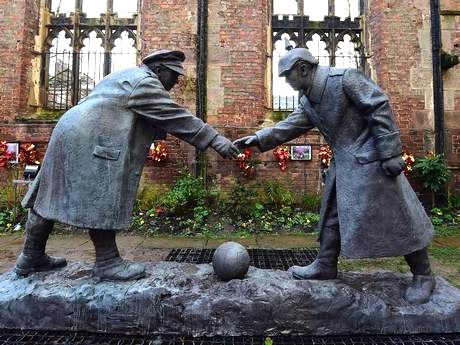Two festive football matches that changed the course of history
The extensive football schedule during the period between Christmas and New Year’s Day has become a staple in every football fan’s calendar. Nowadays, each Premier League football team are expected to play two matches in the final week of the year. However, this busy football schedule is not necessarily a new phenomenon.
Indeed, in the Victorian era, football, a traditionally working-class sport, was played on Christmas day as conventionally public working-class events took place on days off for workers. This continued into the Edwardian era, when, in 1913, Liverpool played three games in just three days.
The primary reason for this tradition is simply that football clubs took advantage of bank holidays as they offered the possibility of mass attendance. While many standout matches occurred during this period, there are two that changed the course of history, coincidentally both taking place during World War One: The Dick, Kerr’s Ladies match and the Christmas Truce.
Football charity matches organised by ammunition factories were one of the central methods for those on the home front to support the wounded, as they donated all the funds raised by the match to those who had been injured by ammunition. One of the most successful ammunition factories in doing this was the Dick, Kerr factory.
Football was used as a time for people to come together during the festive period
The Dick Kerr factory in Preston was originally a tramway rolling stock and electrical works, although, due to the demand for ammunition, it began to manufacture shells. In order to boost morale amongst its workers during wartime, the Dick, Kerr factory followed suit in creating both a male and female football team. After showcasing their talents by beating the male factory workers in a friendly match, the female Dick, Kerr football team began to play against the other women’s factory teams in the local area, leading up to the crucial match against Arundel Coulthard Factory on Christmas Day 1917.
This pivotal match conjured an audience of 10,000 and rendered the Dick, Kerr female team a force to be reckoned with in the football world. Led by team captain Alice Kell, the team won a victory of 4-0 against the neighbouring Arundel Coulthard Factory at Deepdale, the home ground of Preston North End. Not only did this match cement the status of the Dick, Kerr Ladies, but it also raised £600 for the wounded soldiers at The Matron of the Moor Military Hospital. Significantly, the women maintained their day jobs making munitions but took to the pitch in each spare moment, with each penny raised going directly to charity to help wounded soldiers.
Although now often forgotten, the Dick, Kerr Ladies were trailblazers in women’s football and the match on Christmas Day 1917 was only the beginning. Even after the FA banned women from playing on Football League grounds in 1921, the team continued playing up until 1965.
Another historical football match that took place during the festive period was the match between the British and German troops in No Man’s Land on 24 December 1914. The Christmas Truce has become an integral part of the story of World War One. While there is no confirmation that the football matches between German and British soldiers actually happened, that has not stopped the story from being shared through generations.
On Christmas Eve, 1914, soldiers laid down their weapons and emerged from their trenches to congregate in No Man’s Land. What followed was a truce that was never to be seen again during the war.
In the BBC podcast Witness History, soldiers who were present during the truce tell their side of the story. Col Johannes Niemann, a second lieutenant during WWI, explains that the football match was very much impromptu and began amongst the German and British soldiers sharing photos and singing Christmas carols. He even reports one of the results: 3-2 to Germany.
The Christmas armistice has been immortalised in history, even becoming a part of popular culture, used in 2014 by Sainsbury’s in their Christmas advert.
These two examples demonstrate that football was used as a moment of peace and as a time for people to come together during the festive period. It is unknown whether we will experience a football match as momentous as these two this Christmas. However, it is clear that this tradition of football during the festive period will live on.

Comments